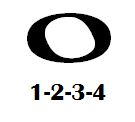| This reading music lesson is a supplement to the Alfred’s Essentials of Music Theory self-study workbook. While no book is perfect for learning how to read music, this is one of the best available. The concise explanations, brief practice exercises, ear-training CD’s, glossary of music terms, and answer key make it an excellent value. Buy this top-rated self-study course for beginners to advanced musicians and follow along with me. |
The best music theory book for self-study at home available today. Learn how to read and write music in 75 concise lessons you can complete at home. Improve your musical ear with ear-training exercises on 2 included CD's. Test yourself in a review section at the end of each unit. Check your knowledge with the answers in the back of the book.
Whole notes look like an oval shaped notehead that is white in the center and not filled in.

The value of this type of note is 4 counts.
To make sure we are truly recognizing it’s full value, we count the 4 beats in our heads while playing or singing it.

This is where the discussion about finding the beat comes in handy.
Once you’ve learned how to sustain a steady beat, it is much easier to count them going by for a note like this.
For best results, count in your head while tapping a steady beat in your foot. Every 4 beats that you count equals the duration of 1 whole note.
Next up is the half note.
Helpful Rhythm Flashcards
48 rhythm flashcards with 96 different practice patterns that corresponds with the Alfred's Essentials of Music Theory, Book 1.
Fun Rhythm Games
25 different rhythm games that can be done in 5 minutes a day. The rhythm activities help students find the beat, learn note values, and meter. A great resource for piano music teachers and homeschooling parents.
Fun music rhythm games and activities following the Dalcroze method with two CD's. A great resource for music teachers and homeschool parents who want to practice finding the beat and learning rhythm through movement.
A rhythm game activity book with two CD's that follows the Dalcroze method. This is a great resource for music teachers and homeschool parents who want to teach how to find the beat and learn various rhythms through movement.





